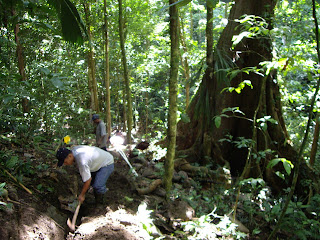I say the world "aqueduct" so much, someone finally had the courage to ask me what one is. So basically it works like this: There is a naturally flowing spring that collects water. First, a capitation box must be built around it to protect the spring from contamination, erosion, and choosing a different path. The water is then piped to a lower elevation to a storage tank. The tank is designed to fill up during the night (when all the taps are closed) and be used during the day (when the taps are in use). The tank is designed for 30 gallons per person per day to include drinking, bathing, and washing clothes and dishes and also assumes population growth. From the tank, which is located at higher elevation than the town, the water is piped through a network of tubing to each house via gravity.
The following pictures are of us burying the tubes.

In my case, I'm using a spring that produces roughly 5 gal/min. We completed the capitation box and are now burying the network of tubing to the tank and to every house. We must bury nearly 3 miles of tubing by hand roughly 2´deep (pick-axes and shovels). Once the tubing is in place, we'll go back and build the 4000 gal concrete tank. For tubing I'm using PVC sized from 1.5" to 1/2" depending on flow, friction losses, and elevation differences. The tank will be concrete block with a poured top with several finish coats. My design assumes potable water from the spring source, but future chlorination at the tank may become necessary.

Since my community has never had potable water before, we must also make our rules and regulations as we go. They have decided to charge $1/month for the water. If the payment is not received for 3 months, they will physically cut-off the service. A new house that didn't donate time to the construction has to pay $80 for a new hook-up as well as tubing required. Every house is allowed only one tap.

Starting Aug. 11 my community will participate in a seminar series devoted to training communities how to manage aqueducts. Nine communities will participate in this series this fall, and eight more next spring. The series - organized and taught by Peace Corps Volunteers ( and funded by donations) - will include topics such as: 1) What is potable water? 2) How to make basic repairs 3) Basic accounting practices 4) How to protect your watershed 5) Leadership building exercises and group-based challenges 6) Community participation and goal planning

I've decided to monitor this seminar series and the following series as well to contribute to my Masters of Science in Civil Engineering. I will specifically study if, how, and why or why not this seminar series correlated to better functioning aqueduct systems. Most local projects fail not because of the design, but because locals lack skills, understanding, or money necessary to maintain their systems. If this link is not made, all projects - no matter how simple - are doomed to fail. This seminar series hopes to improve this link between designers and managers.

 In my case, I'm using a spring that produces roughly 5 gal/min. We completed the capitation box and are now burying the network of tubing to the tank and to every house. We must bury nearly 3 miles of tubing by hand roughly 2´deep (pick-axes and shovels). Once the tubing is in place, we'll go back and build the 4000 gal concrete tank. For tubing I'm using PVC sized from 1.5" to 1/2" depending on flow, friction losses, and elevation differences. The tank will be concrete block with a poured top with several finish coats. My design assumes potable water from the spring source, but future chlorination at the tank may become necessary.
In my case, I'm using a spring that produces roughly 5 gal/min. We completed the capitation box and are now burying the network of tubing to the tank and to every house. We must bury nearly 3 miles of tubing by hand roughly 2´deep (pick-axes and shovels). Once the tubing is in place, we'll go back and build the 4000 gal concrete tank. For tubing I'm using PVC sized from 1.5" to 1/2" depending on flow, friction losses, and elevation differences. The tank will be concrete block with a poured top with several finish coats. My design assumes potable water from the spring source, but future chlorination at the tank may become necessary. Since my community has never had potable water before, we must also make our rules and regulations as we go. They have decided to charge $1/month for the water. If the payment is not received for 3 months, they will physically cut-off the service. A new house that didn't donate time to the construction has to pay $80 for a new hook-up as well as tubing required. Every house is allowed only one tap.
Since my community has never had potable water before, we must also make our rules and regulations as we go. They have decided to charge $1/month for the water. If the payment is not received for 3 months, they will physically cut-off the service. A new house that didn't donate time to the construction has to pay $80 for a new hook-up as well as tubing required. Every house is allowed only one tap.  Starting Aug. 11 my community will participate in a seminar series devoted to training communities how to manage aqueducts. Nine communities will participate in this series this fall, and eight more next spring. The series - organized and taught by Peace Corps Volunteers ( and funded by donations) - will include topics such as: 1) What is potable water? 2) How to make basic repairs 3) Basic accounting practices 4) How to protect your watershed 5) Leadership building exercises and group-based challenges 6) Community participation and goal planning
Starting Aug. 11 my community will participate in a seminar series devoted to training communities how to manage aqueducts. Nine communities will participate in this series this fall, and eight more next spring. The series - organized and taught by Peace Corps Volunteers ( and funded by donations) - will include topics such as: 1) What is potable water? 2) How to make basic repairs 3) Basic accounting practices 4) How to protect your watershed 5) Leadership building exercises and group-based challenges 6) Community participation and goal planning I've decided to monitor this seminar series and the following series as well to contribute to my Masters of Science in Civil Engineering. I will specifically study if, how, and why or why not this seminar series correlated to better functioning aqueduct systems. Most local projects fail not because of the design, but because locals lack skills, understanding, or money necessary to maintain their systems. If this link is not made, all projects - no matter how simple - are doomed to fail. This seminar series hopes to improve this link between designers and managers.
I've decided to monitor this seminar series and the following series as well to contribute to my Masters of Science in Civil Engineering. I will specifically study if, how, and why or why not this seminar series correlated to better functioning aqueduct systems. Most local projects fail not because of the design, but because locals lack skills, understanding, or money necessary to maintain their systems. If this link is not made, all projects - no matter how simple - are doomed to fail. This seminar series hopes to improve this link between designers and managers.



























